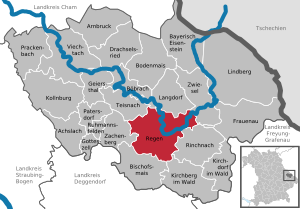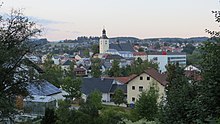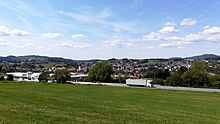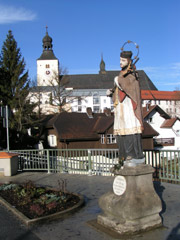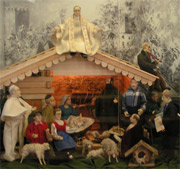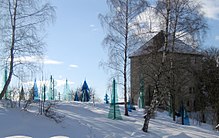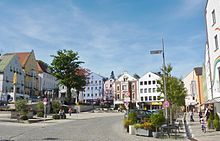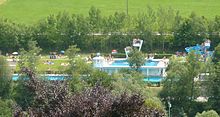Rain (city)
| coat of arms | Germany map | |
|---|---|---|

|
Coordinates: 48 ° 58 ' N , 13 ° 8' E |
|
| Basic data | ||
| State : | Bavaria | |
| Administrative region : | Lower Bavaria | |
| County : | rain | |
| Height : | 532 m above sea level NHN | |
| Area : | 65.12 km 2 | |
| Residents: | 10,988 (Dec. 31, 2019) | |
| Population density : | 169 inhabitants per km 2 | |
| Postal code : | 94209 | |
| Primaries : | 09921, 09922 | |
| License plate : | REG, VIT | |
| Community key : | 09 2 76 138 | |
| City structure: | 57 districts | |
City administration address : |
Stadtplatz 2 94209 Regen |
|
| Website : | ||
| Mayor : | Andreas Kroner ( SPD ) | |
| Location of the city of Regen in the Regen district | ||
Regen is the district town of the district of the same name in the administrative district of Lower Bavaria and is located in the Bavarian Forest on the Schwarzen Regen . The city was named after the river of the same name and has been a state-approved health resort since December 7, 2004 .
City structure
Regen has 57 districts:

The original urban area consists of the districts of Altstadt, Moizerlitz, Bürgerholz, Grubhügel, Riedham and St. Johann.
history
Regen was probably founded by the Rinchnach provost at the end of the 11th century . For the first time the place was on March 30, 1148 in a papal letter of protection from Pope Eugene III. mentioned to the Niederaltaich monastery . In this it was confirmed that the church of Regen belongs to Niederaltaich Abbey. The place developed into an important bridge and border place. A wooden bridge was first mentioned in 1207. It was not until 1902–1905 that after the later King Ludwig III. named Ludwigsbrücke built.
In 1254 Regen - still part of Rinchnach - became a monastery market. Through an exchange contract with Duke Heinrich XIII. with the abbot of Niederaltaich it became a ducal market in 1270 . This development lasted until 1468. In that year Duke Albrecht IV summarized the market rights in one document ( lower jurisdiction , voluntary jurisdiction, decision on police matters). 20 years earlier, Duke Albrecht III had given rain . awarded the city arms.
During the Thirty Years' War Regen was looted and burned by the Swedes in 1633, 1641 and 1648. During the fire that was started on Saturday, December 10th, 1633, a picture of the Virgin survived the fire of a bakery, which later came to Salzburg and temporarily to Nesselwang and led to the establishment of pilgrimage sites there, namely Maria Plain and Maria Trost .
Since the end of the 16th century there have been ox and goods markets. In 1827, after lengthy efforts, the first schoolhouse was built on the Weinbergacker. In 1828 Regen became a municipality. The year 1852 saw the establishment of a girls' school.
On September 16, 1877, the railway line from Plattling to Bayerisch Eisenstein, on which the Regen train station is located, was opened.
20th century
On January 1, 1932, Regen was declared a city .
On April 24, 1945 three bridges were blown up before the American invasion. Fierce fighting broke out, with 36 houses damaged or completely destroyed. 33 German soldiers and 17 civilians died, 79 local families were made homeless.
The American district military government set up its seat in the largely intact neighboring town of Zwiesel , and on July 3, 1945, the district office was also relocated to Zwiesel on their orders . A violent tug-of-war began around the seat of the district administration. Three times, the last time on April 8, 1948, the government of Lower Bavaria ordered the office to be relocated to Regen. But it was not until April 17, 1948, starting at 3:30 a.m., that 49 men, led by District Administrator Werner Haas, managed to return to Regen in ten trucks on ten trucks. There the returnees were celebrated with music and white and blue flags, but the celebrations had to be stopped by order of the military government.
Religions
- Catholic parish of Regen Diocese of Passau
- Catholic Parish March Diocese of Regensburg
- Evangelical Lutheran Church Congregation Regen
Incorporations
In 1917 the village of Heilig-Geist with around 110 inhabitants came to rain. On April 1, 1962, the municipality of Bärndorf fell to the city of Regen, causing the population to rise to 6,500. On April 1, 1964, Neigerhöhe, Riedham, Wieshof and Huberhof followed, which previously belonged to the municipality of Rinchnachmündt. On July 1, 1964, the municipality of Eggenried was added with 1260 hectares and 584 inhabitants. As part of the municipal reform , the municipality of Oberneumais followed on January 1, 1972 with 505 inhabitants and 1241 hectares of municipal area, and on May 1, 1978, the municipality of Rinchnachmündt with 1181 hectares and 939 inhabitants and the municipality of March with 1038 hectares and 743 inhabitants.
Population development
1280 Regen had about 200 inhabitants. By the end of the nineteenth century, that number changed only slightly. In 1828 a population of 1196 and in 1904 of 2366 people were recorded. The 20th century brought a greater increase, in 1974 there were already 9029 inhabitants registered. These growth rates are u. a. due to incorporations , the settlement of displaced persons and the expansion of industry. Due to the variety of offers and the attractiveness of the city, the population continued to grow rapidly, in 2005 Regen already had 12,553 inhabitants. Rain could not escape the general trend (e.g. decline in birth rates), so the population figures declined from 2005 to 2011, but have been increasing again since 2012.
Between 1988 and 2018, the population stagnated or decreased from 11,057 to 11,001 by 56 inhabitants or 0.5%.
politics
mayor
Andreas Kroner (SPD) has been the first mayor since May 2020. He prevailed in the runoff election on March 29, 2020 with 59.32% of the vote.
Ilse Oswald (* 1953) ( FWG ) served from December 2006 to April 2020 .
City council
The local elections of March 15, 2020 and earlier resulted in the following allocation of seats:
| CSU | Free voters | SPD | GREEN | total | |
| 2020 | 9 | 7th | 5 | 3 | 24 |
| 2014 | 9 | 7th | 5 | 3 | 24 |
coat of arms
Blazon: a white lily and above it a rainbow in a blue field in the shield (text from the original document from 1448). The coat of arms was given to the then market town in 1448 by Duke Albrecht III. awarded. The city colors are red - yellow - blue.
The rainbow stands for the place name and the lily is the place symbol that can be found in seals of the community in the 17th century.
Town twinning
Regen maintains partnerships with the Hessian city of Eschwege (since 1997; city friendship since 1967), with the French Mirebeau and with the Franconian city of Roth .
Sponsorship
- Heimatkreis Bergreichenstein e. V. (Czech Kašperské Hory , since 1984)
Culture and sights
Museums
- In 1988 the Lower Bavarian Agricultural Museum was opened in an Art Nouveau building on the town square, which was previously used as a district and district office. As early as the 1930s, citizens of Regen began collecting objects for this museum project. In 1966 the first attempt to open a rural museum failed.
- The museum in the Eating House , which opened in the 1980s, exhibits snuff glasses, a folklore collection, items recovered from the excavations around the castle ruins and Siegfried von Vegesack's study . The 900-year-old building served as a granary for Weißenstein Castle, was used as a restaurant in the 19th century and later used as a residential tower by the poet Siegfried von Vegesack and his wife Clara Nordström .
- Bergreichenstein local history museum
- The Pscheidl nativity scene with almost 300 figures stood in the Pscheidl house on Ludwigsbrücke until the death of Mrs. Pscheidl-Krystek. In addition to the well-known biblical people, more or less important personalities of the city were modeled as fabric figures.
music
- Liedertafel Regen from 1852
- Spielmannszug Volunteer Fire Brigade Regen e. V., founded in 1973
- Marching band rain
- Wind Orchestra of the City of Regen e. V., founded in 1994.
Buildings
- City parish church of St. Michael
- St. John's Church
- Holy Spirit Church ; this was built in 1421–1425 as a hospital church.
- The Protestant church was built from 1957 to 1958.
- The Weißenstein castle ruins are located in the Weißenstein district , two kilometers south of the town square.
- The Transparent Forest has been built in front of the Museum Fressendes Haus since 2000. This is an award-winning and steadily growing collection of glass sculptures in the shape of a tree.
- The Marienbrunnen, built in 1948 as the new center of the town square (in place of the earlier town hall, which was demolished in the nineteenth century), was moved in 2012 as part of the general renovation of the town square in the direction of Ludwigsbrücke. The Marian Column is from 1872. The town square is surrounded by houses from the 19th century, including the town hall from 1820.
- Beer and ice cellar (since spring 2009, Postkeller friends have been activating the old cellars that can still be walked in on Pflegegasse)
Parks
- The spa park on the Regeninsel was set up in the late 1980s on the site of a former sawmill and also includes a small network of paths up the river. In 2004/05 the spa park was expanded to include a factory site on the opposite side of the river, which had previously been fallow. In addition to landscape gardening, various sculptures and the glass knot can be seen in the spa gardens.
- The Waldschmidtpark borders on the spa park extension from 2004/05 and is a piece of forest located on the so-called Sauheng . Part of this park is the Malerwinkel, which got its name because of the good view of the river and the city.
Natural monuments
- The pile is a 150 km long range of quartz rocks. In the Weißenstein district it reaches its highest point at over 750 m, where Weißenstein Castle was built.
Sports
- Freetime activities
Various team and individual sports, such as Badminton, basketball, billiards, darts, ice skating, curling, fistball, gym, soccer, weightlifting, handball, ju jutsu, canoeing, karate, climbing, athletics, cycling, chess, swimming, skiing, tennis, table tennis, hiking.
- Sporting events and successes
- In the winter of 1961 the 11th European Ice Stock Championships took place on the Regener See . In 1982 and 2009 they were held in the ice rink. In 1971 the women of TSV Regen won the team title.
- In 1964 the 1st Lower Bavarian Youth Games were held in Regen .
- In 1990 the weightlifting division of TSV Regen became German team champions.
Regular events
- The Pichelsteiner Festival, first celebrated in a small group in 1874, is today the largest festival in the Bavarian Forest. The name of the festival comes from the dish of the same name . In the course of time, the Pichelsteiner Serenade by the Regen Wind Orchestra (Thursday), a parade (Sunday), an evening gondola ride (Saturday), a large fireworks display (Wednesday) and water games were added as a supporting program. In 1938, the master painter Friedrich Biller from Regen designed the Pichelsteinerbübchen as the festival's trademark.
- Since 1957 the Easter Ride, organized by the local branch of the Catholic rural youth movement , has taken place every Easter Monday . Every year around 500 riders with their horses take part in the ride through the city and the blessing of the festively decorated horses.
- Every two years (even years) the folk music event around it , the largest folk music festival in Bavaria, takes place in Regen on Whitsun . Over 50,000 visitors from near and far flock to the city to listen to the hundreds of music groups that are playing all over the city, to dance, to attend various folk music seminars and the musical instrument fair.
- In the years between the trappings, a river stage is set up in August. Here musicians of the most varied musical styles make music on a stage built in the rain river.
- During the summer months, concerts are held every Sunday morning in the pavilion on the spa island.
- Poetry readings in the Eating House and the city library
- The knight spectacle with a large medieval market takes place in Weißenstein every two years.
- There are Christmas markets on the 1st weekend in Advent along the Regener Kurpark, and on the 2nd / 3rd. Advent weekend in the Schweinhütt district ( forest Christmas ).
Economy and Infrastructure
In Regen there are over 5600 jobs subject to social insurance as well as several commercial / industrial areas.
With over 30 specialty shops and a department store, the Regen shopping park offers a wide range of shopping opportunities.
Bank branches in Regen run the Postbank, Sparda-Bank, Sparkasse and VR-Bank.
health care
- General practitioners
- Pharmacies
- Specialists (examples)
- Ophthalmology
- surgery
- Gynecologists
- ENT
- Dermatologists
- Internists
- Orthodontics
- Pediatricians
- Neurosurgery
- neurology
- Oral surgery
- Orthopedics
- urology
- Naturopath
- Physiotherapy practices
- Speech therapists
- Medical care centers (MVZ)
- Orthopedic technology / medical supply stores
- Veterinarians
- dentists
The Bavarian Red Cross holds a rescue station in the rain.
Care facilities
- Nursing home
- Outpatient care services
- Assisted living for seniors
- Assisted living for disabled people
Large resident companies (extract)
- Rodenstock GmbH
- Qioptiq GmbH & Co. KG
- Schock GmbH
- Holz Schiller GmbH
- former companies
- Max Biller cement and concrete plant
- Bachl cement and concrete works
- Matchstick factory Müller (from 1863; the building later goes to Rodenstock)
- Orgelbauanstalt Edenhofer (1850–1897)
traffic
- Two federal highways ( B11 and B85 ) unite thirteen kilometers west of the city near Patersdorf and separate south of the city towards Passau and Bayerisch Eisenstein.
- Connection to the Plattling – Bayerisch Eisenstein line every hour by Waldbahn trains with the Regen and Triefenried stations (near March )
- Regional and city bus routes connect the city with the surrounding area. There is a bus station at the train station .
- The city is integrated into the " National Park Transport Concept Bavarian Forest " with the Bayerwald-Ticket network ticket and from December 1, 2010 GUTi guest card.
- Since May 2016 there have been on-call buses in the entire Regen district, including in the city of Regen. Of these, five lines now run to and from Regen.
media
- Bavarian Forest Messenger
- City indicator
Public facilities
- Offices
- Office for Food, Agriculture and Forestry
- employment exchange
- court House
- Health department
- Veterinary office
- Police inspection
- Education Office
- City administration
- Notary
- Aid organizations
- Bavarian Red Cross
- Caritas
- Volunteer Fire Brigade Rain
- Kolping Society
- Life support for the disabled
- Rescue dog teams
- technical aid organization
- VdK
education
- 4 kindergartens / 2 day nurseries / 1 daycare facility
- 2 primary schools
- Middle school (M 10 train)
- secondary school
- Vocational school, special vocational school
- Technical college (social affairs, technology, economics) possible up to FOS13 (= general university entrance qualification)
- Vocational school (technology)
- Special schools
- vhs - Adult Education Center for the Regen district
- music school
garrison
Regen has been the location of the Bundeswehr since 1960 . The Panzergrenadierbataillon 112 (or at times Jägerbataillon 112 ) has been stationed in the Bayerwald barracks for decades and is currently subordinate to the 12th Panzer Brigade .
Honorary citizen
- Anton Primbs, July 12, 1881
- Josef Schmid (P. Bernhard, OSB), November 6, 1884
- Anton Wisberger (district doctor), October 11, 1886
- Josef Grassl (elementary school teacher), September 1, 1888
- Franz Xaver Wieberger (beneficiary), November 2, 1894
- Franz Xaver Geyer (Mission Bishop), October 11, 1912
- Franz Xaver Heindl (Chief Magistrate), April 27, 1914
- Johann Partheter (Chimney Sweeper, Mayor), November 25, 1915
- Alois Müller (factory owner), December 17, 1917
- Josef Rodenstock (factory owner), January 27, 1918
- Hans Vogel (Professor, Privy Councilor), July 29, 1932
- Gotthard Oswald (pastor), June 27, 1947
- Franz Xaver Geyer (athlete), April 5, 1950
- Wilhelm Schwinn, July 22, 1969
- Johann Baptist Falter (owner of the Falter brewery ), February 18, 1971
- Rolf Rodenstock (factory owner), February 24, 1977
Personalities
- Heinrich von Pechmann (born February 26, 1774 in Regen; † July 4, 1861 in Munich), architect, hydraulic engineer and author
- Adalbert von Pechmann (born October 20, 1777 in Regen; † March 9, 1860 in Passau), Passau auxiliary bishop, cathedral dean and vicar general
- Jakob Ertl, writer (1875–1957)
- Clara Nordström , Swedish writer (1886–1962)
- Siegfried von Vegesack , Baltic poet (1888–1974)
- Josef Schwannberger (born May 19, 1893 - March 19, 1969), master carpenter; Honorary letter holder (1953) and honorary mayor (1960)
- Paul Groß (born December 15, 1922 in Dresden; † June 16, 1963 in Regen), politician and member of the state parliament (SPD)
- Josef and Maria Pscheidl, builders of the Pscheidl crib
- Willi Killinger (born October 5, 1943 in Bettmannsäge), local politician (CSU)
- Reinhold Otto Werner (1947–2015), Romanist, Hispanicist and lexicographer
- Ruth Hagengruber (* 1958), philosopher
- Josef Braml (* 1968), political scientist
- Thomas Götz (* 1968), psychologist
- Anton Schmaus (born August 21, 1981), Koch, with a star in the Michelin guide awarded
Other facilities
- Cinema center (3D cinema)
- Sports camp and youth holiday village Raithmühle of the BLSV , founded in 1957 by Gottfried Sandner (vice principal at the Regener Hauptschule, died 1974)
- Ice rink
- outdoor pool
- Soccer fields
- Mini golf course
- Sports halls
- City library
- Kalina Gallery
- Regener See , an artificial black rain reservoir
Web links
- City rain
- Entry on the coat of arms of Regen (city) in the database of the House of Bavarian History
Individual evidence
- ↑ "Data 2" sheet, Statistical Report A1200C 202041 Population of the municipalities, districts and administrative districts 1st quarter 2020 (population based on the 2011 census) ( help ).
- ↑ a b c City Council Election & Mayoral Election in Regen 2020 - Candidates & Results. In: Wahl.info. March 29, 2020, accessed May 4, 2020 .
- ↑ http://www.bayerische-landesbibliothek-online.de/orte/ortssuche_action.html ? Anzeige=voll&modus=automat&tempus=+20111211/163148&attr=OBJ&val= 786
- ^ Wilhelm Volkert (ed.): Handbook of Bavarian offices, communities and courts 1799–1980 . CH Beck, Munich 1983, ISBN 3-406-09669-7 , p. 533 .
- ^ Federal Statistical Office (ed.): Historical municipality directory for the Federal Republic of Germany. Name, border and key number changes in municipalities, counties and administrative districts from May 27, 1970 to December 31, 1982 . W. Kohlhammer, Stuttgart / Mainz 1983, ISBN 3-17-003263-1 , p. 622 .

